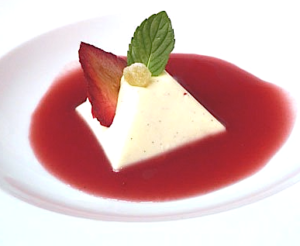 Before embarking on this recipe I have defined a three cooking terms: Fumet, Veloute and Sweating.
Before embarking on this recipe I have defined a three cooking terms: Fumet, Veloute and Sweating.
Veloute
Wikipedia defines Veloute as a light stock (one in which the bones used have not been previously roasted), such as chicken, veal or fish stock, that is thickened with a blond roux. Thus the ingredients of a velouté are equal parts by mass butter and flour to form the roux, a light chicken, veal, or fish stock, and salt and pepper for seasoning. Bottom line, Veloute is basically a Bechamel sauce made with stock instead of milk. Commonly the sauce produced will be referred to by the type of stock used, for example, chicken velouté, or in this case, oyster veloute.
Fumet
The recipe calls for 2 cups of fumet which is a concentrated stock made from fish or mushrooms, used to add flavor to less intensely flavored stocks or sauces. You can make your own fumet stock or you can purchase this in a gourmet market. I have provided a link to purchase this at FormaggioKitchen.com, which I find much easier to do.
Sweating vs. Sauteeing
The recipe calls for “sweating” which is a cooking process similar to sauteeing that helps draw out moisture from aromatics (such as onions, garlic, carrots celery) cooked in a small amount of fat; typically butter or olive oil, but most fats will do. The fats absorb the flavors released during the sweating process. This is done over low heat in a covered skillet. This enables the sweating/steam process which soften the ingredients. In this recipe we are sweating shallots, fennel, leeks, thyme, parsley, and bay leaves. Once the aromatics are translucent (you can see this best in the shallots), the process is complete. Unlike sauteeing, we are not looking to brown the aromatics, so it is good to stir the ingredients so no browning can occur.
Chilled Oyster Veloute with Black River Caviar
Recipe courtesy of Black River Caviar created by Douglas Keane- Executive Chef/Owner Cyrus Restaurant
Ingredients
- 1/2 bottle champagne
- 2 cups fumet
- 2 cups shucked oysters and their liquor (reserve some oysters for plating)
- For each serving:
- 1 each, shallots (minced)
- 1/2 each, fennel bulb (sliced)
- 1 each, leeks (white part only, washed and sliced thin)
- 1/2 bunch thyme (chopped)
- 1/2 bunch parsley stems (chopped)
- 1 each bay leaves
- 2 cups heavy cream
Instructions
- Heat a pan over medium low heat until
hot. Add a small amount of oil (no more than 2 tablespoons) to the pan
and swirl to coat. Let the oil heat for a few seconds. Add and sweat
shallots, fennel, leeks, thyme, parsley, and bay leaves, in a little
butter until tender. Make sure to get no color. - Add oysters and their liquor and reduce.
- Add champagne and fumet and reduce by 4/5.
- Strain and transfer to another cooking vessel.
- Add heavy cream, bring to a boil and reduce until desired consistency.
- Chill well. Refresh with some fresh oyster liquor before serving.
Plating the Dish
- In a large bowl place two or three freshly shucked oysters
- Top each oyster with a large dollop of Uruguayan Black River Caviar and sprinkle fresh chives on top.
- Pour chilled soup at the table around oysters. Serve immediately
About Chef Douglas Keane
Since
opening Cyrus, Chef Douglas Keane has received many accolades,
including being named Food & Wine magazine’s “Best New Chef,” and
San Francisco magazine’s “Best Chef. He has received a four-star review
from the San Francisco Chronicle and two stars from the esteemed
Michelin Guide.
A Detroit native and graduate of Cornell
University’s prestigious School of Hotel Administration, Keane spent
several years working in New York at the acclaimed Four Seasons and
under Gray Kunz at Lespinasse, before making the move to San
Francisco’s venerable Jardinière where he was honored by the San Francisco Chronicle as a “Rising Star Chef.”


